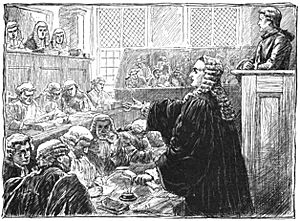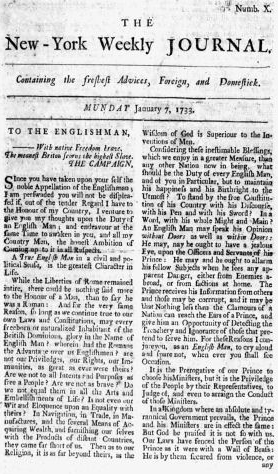John Peter Zenger facts for kids
Quick facts for kids
John Peter Zenger
|
|
|---|---|

Andrew Hamilton defending John Peter Zenger in court, 1734-1735
|
|
| Born | October 26, 1697 Impflingen, or Rumbach
Rhenish Palatinate |
| Died | July 28, 1746 (aged 48) |
| Citizenship | British |
| Occupation | Newspaper writer |
| Years active | 1720–1746 |
| Known for | Zenger Trial |
|
Notable work
|
The New York Weekly Journal |
John Peter Zenger (October 26, 1697 – July 28, 1746) was a German printer and journalist in New York City. He became famous for a very important court case in 1735. This case helped establish the idea of freedom of the press in America. It meant that newspapers could print the truth, even if it criticized powerful people.
In 1733, Zenger started printing The New York Weekly Journal. This newspaper shared opinions that were critical of the colonial governor, William Cosby. Governor Cosby ordered Zenger's arrest in November 1734. Zenger was charged with libel, which means printing false information that harms someone's reputation.
However, a jury later found Zenger not guilty. His lawyers, Andrew Hamilton and William Smith, Sr., successfully argued that if what was printed was true, it could not be libel. Zenger's acquittal became a symbol for the importance of a free press.
Contents
Early Life and Printing Career
John Peter Zenger was born in 1697 in a region of Germany called the German Palatinate. His family moved to New York in 1710. Many German families immigrated to New York around this time.
Sadly, Zenger's father died during the journey. The governor of New York arranged for the children of these immigrants to become apprentices. John Peter Zenger became an apprentice to William Bradford. Bradford was the first printer in New York.
Zenger worked for Bradford for eight years. By 1720, he began doing printing work in Maryland. He returned to New York permanently by 1722. After a short partnership with Bradford in 1725, Zenger started his own printing business. He set up his shop on Smith Street in New York City.
Zenger married Mary White in 1719. After she passed away, he married Anna Catharina Maul in 1722. He had several children with his second wife.
The Famous Libel Case
In 1733, John Peter Zenger began printing The New-York Weekly Journal. This newspaper often criticized the actions of the new colonial governor, William Cosby. Governor Cosby had a big disagreement with the colony's council about his salary. He even removed the Chief Justice, Lewis Morris, who had ruled against him.
Zenger's newspaper, supported by people who disagreed with the governor, kept publishing articles that criticized Cosby. Finally, Governor Cosby issued a statement condemning the newspaper. He called its articles "scandalous, virulent, false and seditious reflections."
Zenger was then charged with libel. His first lawyer, James Alexander, was removed from the case by the court. Zenger spent more than eight months in prison.
The Trial and Verdict
Zenger's trial began with great public interest. He was defended by two skilled lawyers: Andrew Hamilton from Philadelphia and William Smith, Sr. from New York.
During the trial, Chief Justice James DeLancey often disagreed with Hamilton. So, Hamilton decided to speak directly to the jury. He argued that Zenger should not be found guilty if the things he printed were true.
On August 5, 1735, the lawyers finished their arguments. The jury left to make their decision and returned in just ten minutes. Their verdict was "not guilty."
Impact on Freedom of the Press
The Zenger trial was a very important moment for freedom of the press in America. Hamilton and Smith tried to show that if a statement is true, it cannot be considered libel, even if it criticizes someone.
While this case was a major step, it didn't immediately change all laws. Later governors still tried to control what newspapers printed. However, the Zenger case laid the groundwork for the idea that people have the right to print the truth. This idea became a core principle of freedom of the press in the United States.
The "Cato" Article
In February 1733, an opinion piece appeared in The New York Weekly Journal. It was written under the pseudonym "Cato." A pseudonym is a fake name used by a writer.
This name was used by British writers John Trenchard and Thomas Gordon. Their essays, called Cato's Letters, were very popular in America.
The "Cato" article in Zenger's paper talked about the same idea that Zenger's lawyers would use later. It argued that truth should be a complete defense against charges of libel. This article helped prepare readers for the important legal argument that would come during Zenger's trial.
Death
John Peter Zenger died in New York on July 28, 1746. He was 48 years old. After his death, his wife continued to run his printing business.
Legacy and Honors
John Peter Zenger is remembered as a hero for freedom of the press.
- During World War II, a ship called the SS Peter Zenger was named in his honor.
- Zenger was the name of an underground newspaper in Madison, Wisconsin, in the late 20th century.
- Zenger News is a modern wire service run by journalists.
See also
 In Spanish: John Peter Zenger para niños
In Spanish: John Peter Zenger para niños



